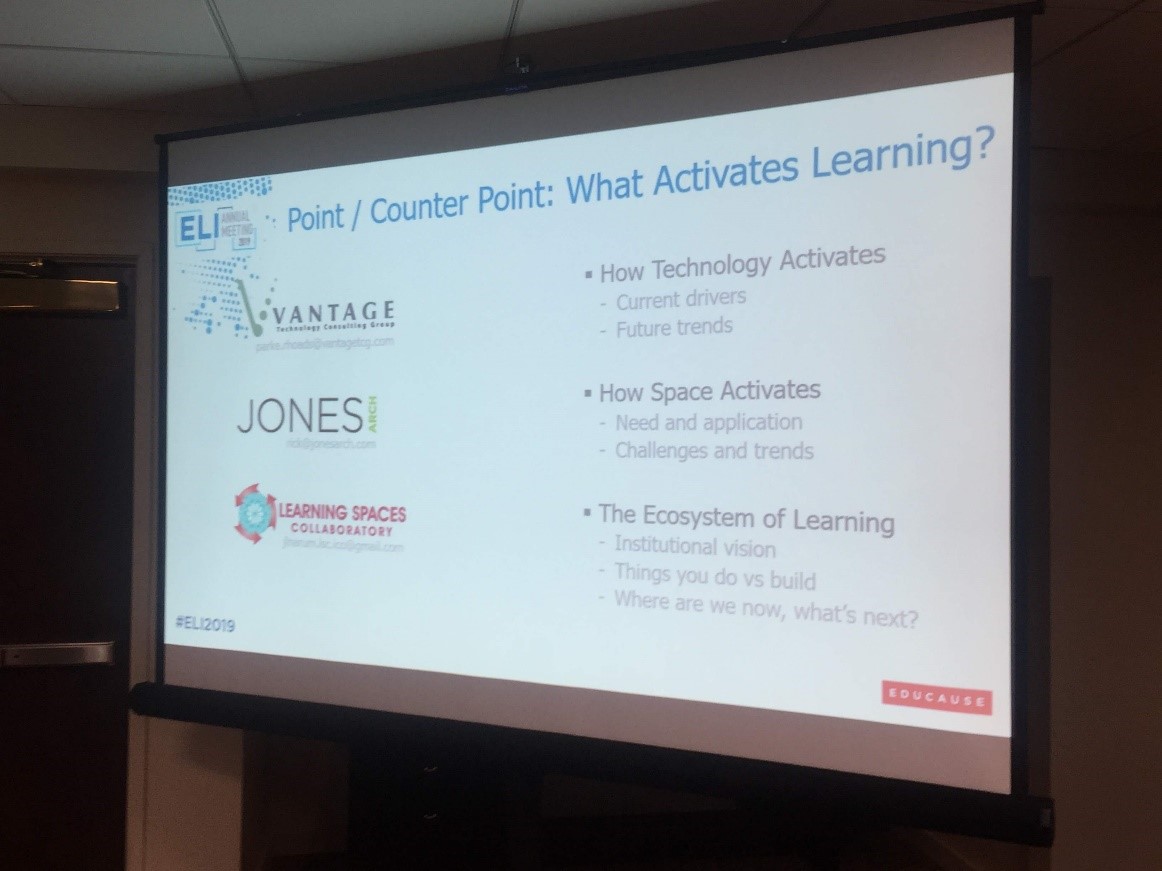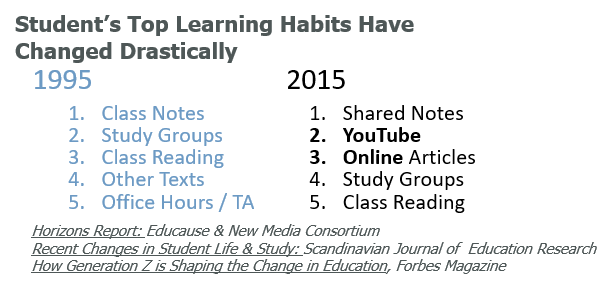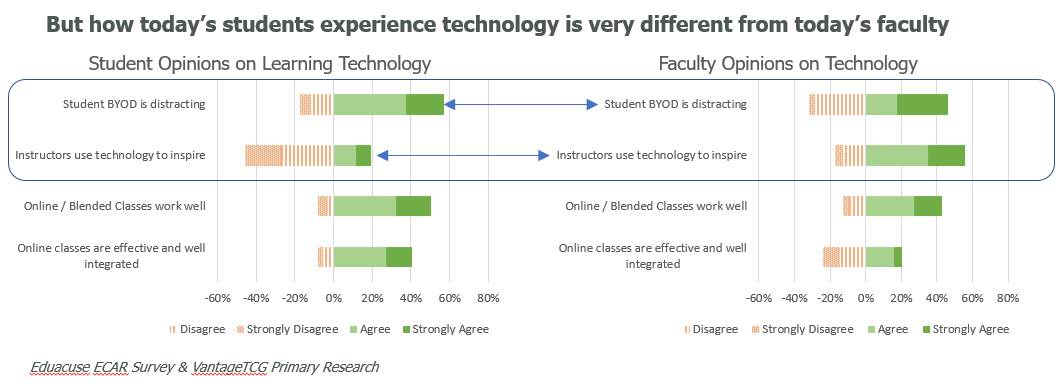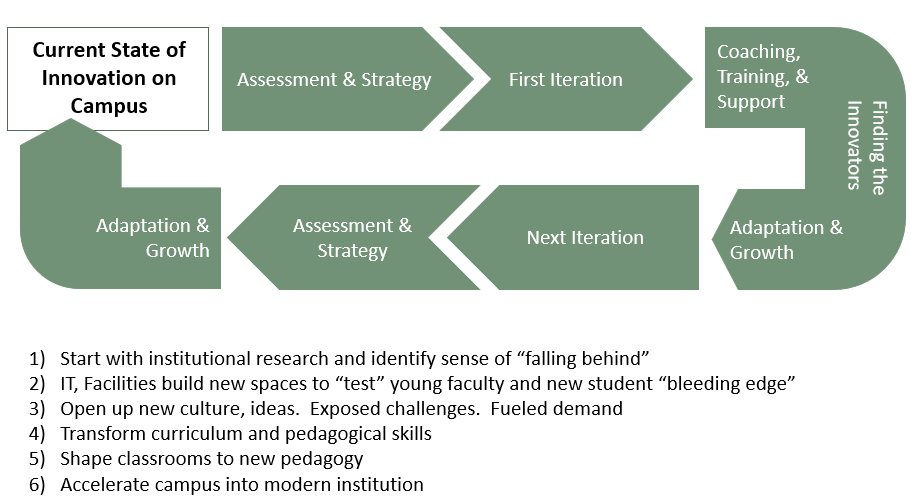The annual EDUCAUSE Learning Initiative (ELI) meeting was held in Anaheim in February. ELI is a community of pedagogy, curriculum design, and instructional technology leaders from higher education institutions and organizations advancing learning through information technology innovation.
Vantage Principal Parke Rhoads led the technology portion of a Point/Counterpoint discussion on “What Activates Learning? Space vs. Technology”. Parke was joined by Rick Jones, director at Jones Architecture, representing the space point of view and Jeanne Narum from Learning Spaces Collaboratory (LSC) as the moderator.
Visual examples from project collaborations at Norwich University and Dartmouth College between Vantage and Jones Architecture peppered the presentation with real-life examples.
What Activates Learning?
Jeanne Narum kicked off the presentation by asking two questions and sharing how these questions had been answered at several universities:
- What do you want your learners to become?
- What experiences make that becoming happen?
Jeanne went on to mention how the LSC Roundtables that are regularly held throughout the US help answer these difficult questions. The roundtable discussions are designed to focus on the future of planning 21st century learning spaces for 21st century learners. The outcome is that roundtable participants leave with a deeper understanding of educational theories, an outline for action on their home campuses and a sense of commitment to the adventure of shaping spaces that will take their institutions into the future. Jeanne also talked about the “Learning Ecosystem” or seeing past an individual classroom to view how all parts of the building, campus, students and faculty work together.
Technology Activates Learning
With his technology blinders on, Parke started out with the premise that technology equals active learning. Using quotes from Vantage’s primary research, EDUCAUSE ECAR Survey and the Horizons Report, Parke pointed out how student learning habits have become dramatically technology-dependent in the last 20 years. He also identified that laptops and smartphones are the preferred learning devices for modern day students.
While everyone agrees that technology is important to learning today, how students experience technology is different from how the faculty experiences technology.
In addition, employers report a widening gap in how graduating students and faculty compare their work skills with how employers’ rate them on categories such as working with others on teams, current on technology and trends, working with numbers, being innovative and creative and applying their knowledge to the real world.
The bottom line is that traditional lectures and curriculum are not keeping pace with employer expectations and institutions need to better teach students the tools and methods they need to use to tackle the problems of the future.
Space Activates Learning
Arguing that it is the space that activates learning, Rick shared conflicting views from post-occupancy feedback from some of his projects:
“This space has spoiled me for other classrooms on campus; I cannot teach anywhere else!”
“I cannot teach in this room; the technology is overwhelming.”
What drives this challenge? Rick wondered if it was the age of faculty, the technology ease of use, the desire to engage the technology, lack of training or all the above. Rick went on to say that the future classroom must be adaptable in response to multiple pedagogical modes, readily support collaborative work and be equipped with appropriate technology and furniture.
Active learning means 100 things to 100 people which makes it critical to include more than just the faculty in classroom planning discussions. Additional players that impact decisions around learning and technology include the provost, deans, facilities, students, TA’s, IT, registrar, librarians, planning, AV team, and alumni. A successful project must show empathy to all constituents and turn them into champions for the project.
At Harvard University, Rick and his team worked with faculty from Arts & Sciences to pilot a “future” undergraduate classroom. In this pilot, the technology included a single projector, multiple whiteboards for instructors and teams, and flexible furniture that could be easily reassembled throughout the room.
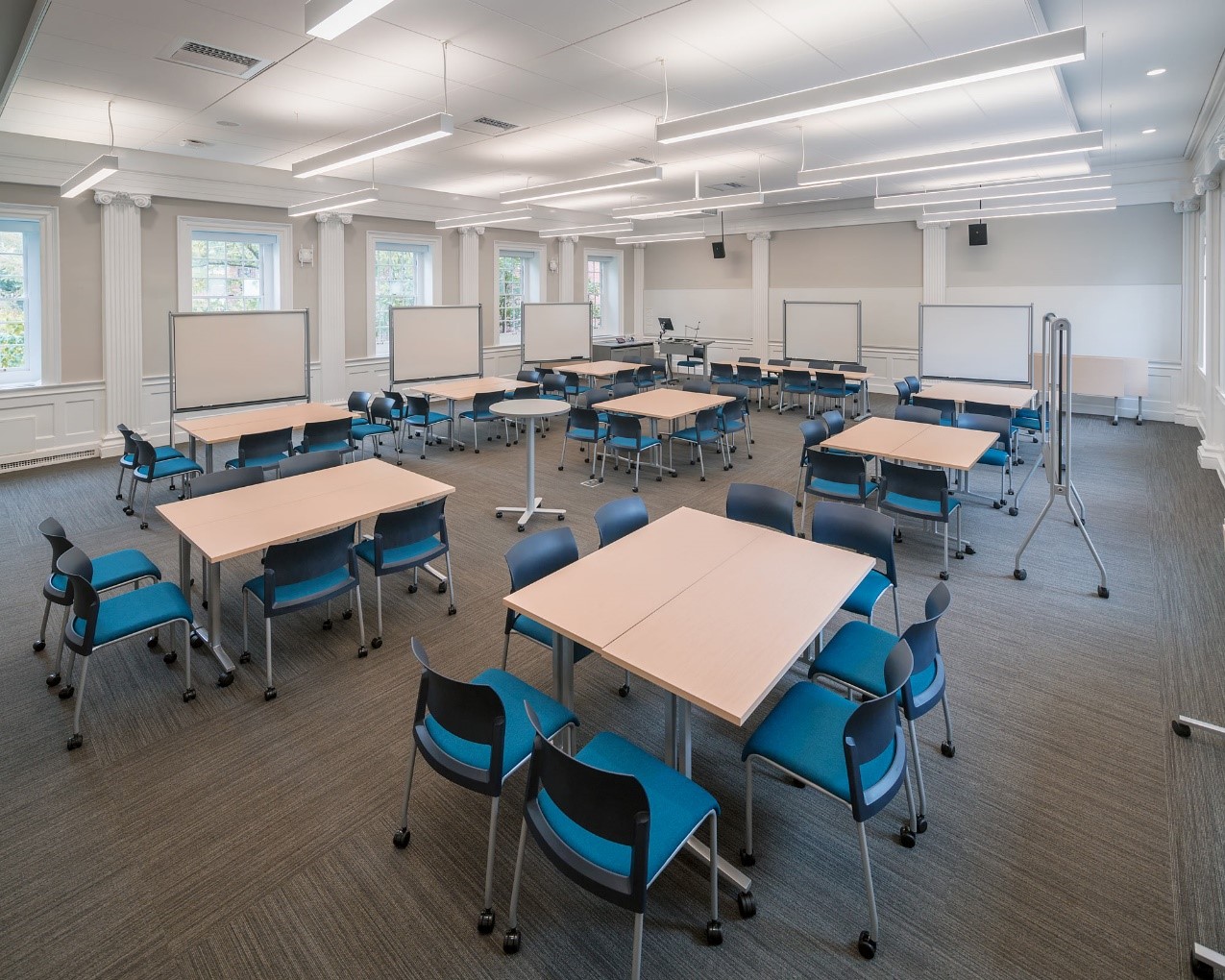
Pilot “future” undergraduate classroom in Harvard Hall developed with the faculty of Arts & Sciences Harvard University and Jones Architecture Inc., 2016
Rick referred to this type of low-tech classroom as “Squeak & Hum”. Squeak & Hum named for the sounds that anyone walking by the classroom will hear – i.e., the squeak of markers on the whiteboard and hum of collaborative conversations between the professor and students. Professor Harry Lewis details his experience with developing this type of classroom in an article titled “Reinventing the Classroom” published in Harvard Magazine.
Additional questions that must be asked in the planning phase include:
- How do we balance the need for general classrooms against the need for more specialized demands or research needs?
- What level of technology is appropriate for each institution’s culture?
The Ecosystem of Learning
The ecosystem of learning encompasses both technology and space. So, what do we need for the ecosystem of learning?
We need:
- Curriculum that engages students in a way that motivates development of digital collaboration and work tools
- Spaces where students can access and interact with the digital realm
- Technology that can be leveraged as a platform for students to create and contribute their content
- Places for faculty and curriculum designers to try, gain competency and to create teaching content
The best way to adapt to the pace of innovation in this new ecosystem of learning is to adopt a state of perpetual beta where everyone must learn to design, test, learn and iterate. The ecosystem of learning will also take both new SPACE and new APPROACHES which involves some things you can solve by designing and other things you solve by doing.
New Space – things you solve by designing:
- Discover the right blend of classrooms
- Provide flexible configurations within classrooms
- Maximize seating, given best pedagogy
- Identify appropriate technology
- Find learning spaces everywhere
New Approaches – things you solve by doing:
- Find the innovators on campus (leverage thought leadership and coach academic leadership)
- Experiment with new places, tools and techniques in a perpetual beta
- Find the funding for operations and capital expenditures
- Remember the importance of training, support, evaluation
- Coach effective modern curriculum
- Change the culture and curriculum
- Provide technology support
Permeability of Learning Spaces
Another point raised by Jeanne was the notion of permeability as it relates to learning spaces. Instead of referring to classrooms as “active”, Jeanne believes that next generation learning spaces should be referred to as permeable learning spaces. Permeable learning spaces allow activities, conversations and expertise to move throughout a building, and incorporate ‘soft barriers’ like glass or see-through walls into their design to encourage and facilitate movement, interaction and collaboration. Permeable spaces link inside, outside, public and private space and eliminate the strict distinction between formal and informal learning.
Permeable learning spaces allow activities, conversations and expertise to move throughout a building…and encourage movement, interaction and collaboration.
Jeanne Narum
Campus Transformation and Innovation
Parke wrapped up the presentation by reviewing a flow diagram of how campus transformation is not about buildings or technology, but about learning and improving. The best strategies for active learning are through a constant process of ideating, testing, evaluating and testing. Sometimes, it may be better to be ‘less ambitious’ in transforming a campus and find ways to start small, like putting in motherboards in a room for student use or prototyping a few different classrooms before investing lots of money on new technology or buildings.
The essence of active learning is surviving the new normal of constant innovation which ultimately means teaching, researching and collaborating for interdisciplinary fields which don’t even exist yet. The overall goal of higher education must be to equip students for the state of this future workplace. The direction this is taking is less traditional content delivery and more collaborative, project-based group work reflective of the current workplace and future skill set.
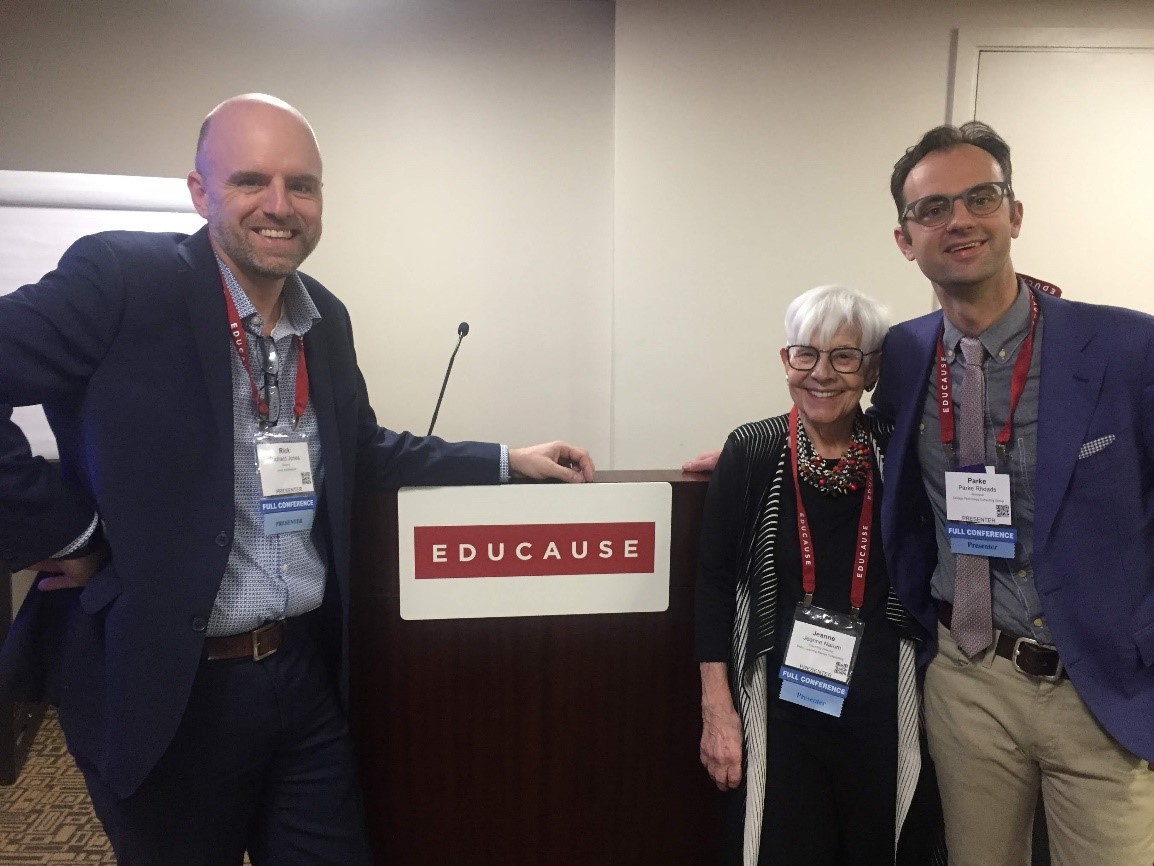
Rick Jones, Jeanne Narum and Parke Rhoads after their ELI presentation

